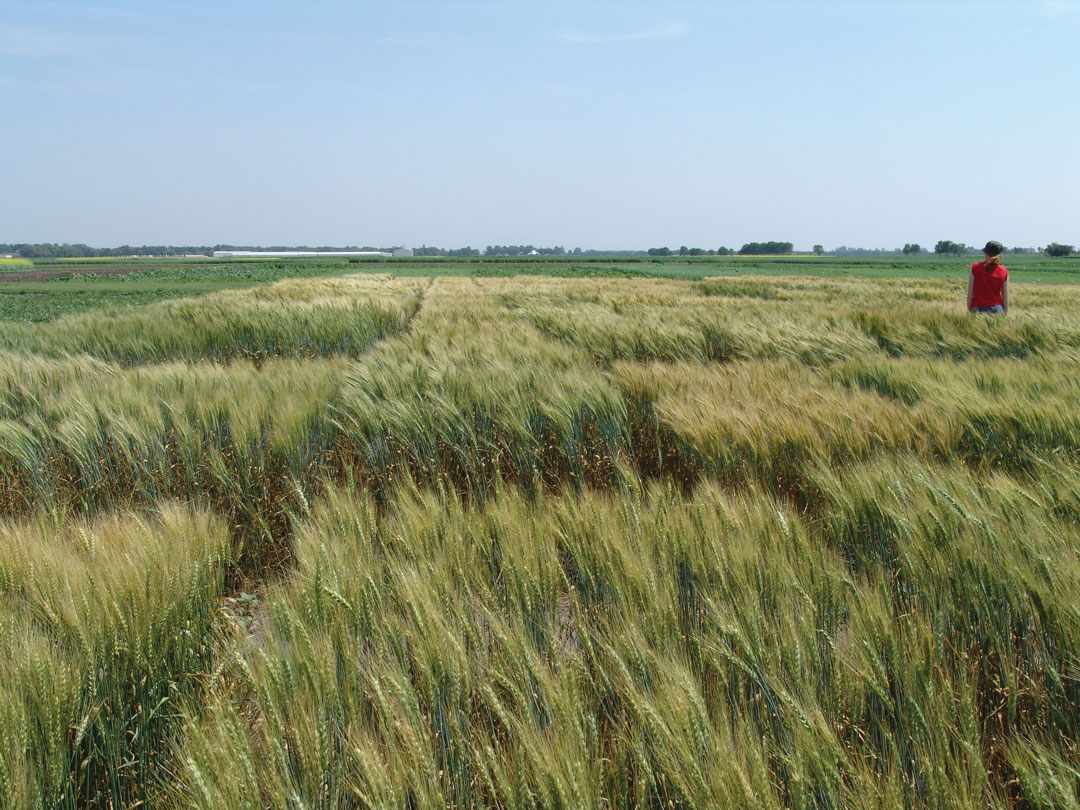NEW FACES IN WINTER WHEAT
BY JENNIFER BARBER • PHOTOS COURTESY OF MARY MELESHKO
Prairie winter wheat acres have declined for years, but interest in the versatile crop has been revived. Its renewed appeal coincides with a changing of the guard in wheat breeding circles. Picking up where their predecessors left off, breeders Harwinder Sidhu and Curt McCartney aim to give farmers strong new varieties.
In summer 2022, Sidhu will take over Agriculture and Agri-Food Canada’s (AAFC) Lethbridge breeding program from well-known researcher Rob Graf who is retiring from the position. Sidhu’s PhD work at the University of Guelph was primarily focused on Fusarium head blight (FHB) resistance in winter wheat. He is eager to expand his genomic research.
“There are many ways to solve breeding problems,” said Sidhu. “We will try new genomic tools and combine them with traditional breeding techniques to continue to build on the work Rob has done, all with the goal of creating higher yielding winter wheat.”
Graf has developed extensive germplasm enriched for disease resistance as well as improved end-use quality. The program’s goal is to add high-throughput genotyping tools to expand screening of this breeding material. In addition, the AAFC program under Graf’s leadership has built a robust germplasm pipeline Sidhu said will serve his research goals well. He will examine the resilience of newly developed varieties in tolerating stress factors such as drought and heat to ultimately improve yield.
Breeders must provide farmers the best possible options, said Sidhu. While breeding timelines often exceed short-term growing trends, he said farmers help target their efforts. Breeders also look at long-term agronomics, disease concerns and market trends to determine variety development goals.
“With the focus on sustainability, winter wheat may become even more interesting to growers a decade from now,” said Sidhu. “If harsh summers continue, winter wheat will fit well as a risk and drought management tool. Our goal is to be prepared with options.”

A LOOK BACK
Graf agreed the historical role of crop breeders had been to produce varieties that serve the needs of farmers and the marketplace. This has shifted over the past two decades. “When I started as a winter wheat breeder in 1999 the focus was primarily on how we could improve yield by focusing on agronomic characteristics and better disease resistance, particularly for the eastern Prairies,” he said. As more winter wheat acres were seeded and breeding efforts evolved, the emphasis moved to broad disease resistance packages and improved end-use quality.
Graf has focused on reducing the risk and cost of production and to increase return per acre. These goals overlap with improvement of yield, agronomic qualities, disease resistance and end-user characteristics.
“The varieties we’ve developed should allow winter wheat to compete in many of the same wheat markets as spring wheat,” said Graf. “I would really like to see Canada Prairie Spring Red and Canada Western Red Winter wheat binned and marketed together, as the quality is now very similar, and it generally isn’t differentiated by the end-user.”
Next for breeders will be to pyramid, or stack, several effective genes for each disease into new varieties, he said. This will be particularly important in beating newly evolved forms of rust. Such development takes time. It will likely be five years or more until these new varieties are commercially available.
“We have always had to improve the value proposition and make winter wheat compelling to grow,” said Graf. “In recent years, wet falls or dry growing conditions have challenged even the most committed growers, altering the perceived value proposition and resulting in lower winter wheat acres.”

A NEW TEAM
Curt McCartney joined the University of Manitoba Department of Plant Science as an associate professor of plant breeding and genetics in November of 2020. He took over the winter wheat program following the retirement of winter wheat breeder, Anita Brûlé-Babel. Most recently, McCartney has worked on the University of Manitoba breeding lines to meet the quality profile expected for the Canadian Western Red Winter Wheat class.
“For winter wheat to be competitive we have to develop milling varieties,” said McCartney. “There is very little market for general purpose winter wheat, so we focus on improving grain quality.”
The university’s well-established FHB nursery benefits its winter wheat disease research. McCartney’s team works with AAFC in Manitoba and Alberta to share data on leaf rust, stem rusts and common bunt while collaborating with other university research programs in Alberta and British Columbia to exchange material in advance of registration of new varieties.
Recent collaborations within the department have also allowed breeding to proceed more expediently, said McCartney. Maneka Malalgoda, who joined the U of M a few months prior to McCartney, is an assistant professor in the university’s Department of Food and Human Nutritional Sciences. Her research into how grain proteins and starch affect the use of wheat in food processing will allow the winter wheat breeding program to begin a wide range of grain quality tests at a much earlier stage of the breeding cycle than previously possible.
It will be important to make high-quality winter wheat varieties available to farmers, said McCartney. These could benefit risk management. As winter wheat generally matures three to four weeks ahead of spring wheat, this could allow it to escape damage caused by hotter, drier summers. While this may be the case, it is unknown whether mild winters work to winter wheat’s advantage, he said. They may improve survival, but mild winters could reduce snow cover and increase winterkill.
“We will continue improving winter hardiness, including researching frost tolerance genes,” said McCartney. “The key will be to create new genetic combinations and see how they perform.”
McCartney will also compare alternative dwarfing genes to so-called “green revolution genes” widely in use. Existing dwarfing genes reduce lodging risk but also increase FHB susceptibility. Alternative dwarfing genes have reduced FHB susceptibility and should have deeper root systems. In theory they could be seeded deeper, making these varieties better for areas of low moisture. “But these are all genetic ideas rather than breeding efforts,” said McCartney. “We look forward to seeing how they will work.”
McCartney and Sidhu are at work to map important winter wheat traits now in the wheat registration system. They aim to catalogue available genetic material so they can focus on genetic diversity when making selections. The project will take five or more years to complete.
Sidhu said he looks forward to carrying out further work with McCartney and for the two breeding programs to grow together. He added this collaboration will produce better breeding results as the growing conditions at his Lethbridge test plots contrast with those at McCartney’s Winnipeg, MB plots.
The leaders of the western Canadian winter wheat breeding programs may have changed, but their intent remains steady. With the assistance of new breeding technologies, Sidhu and McCartney hope to bring the crop back to into prominence.








Comments